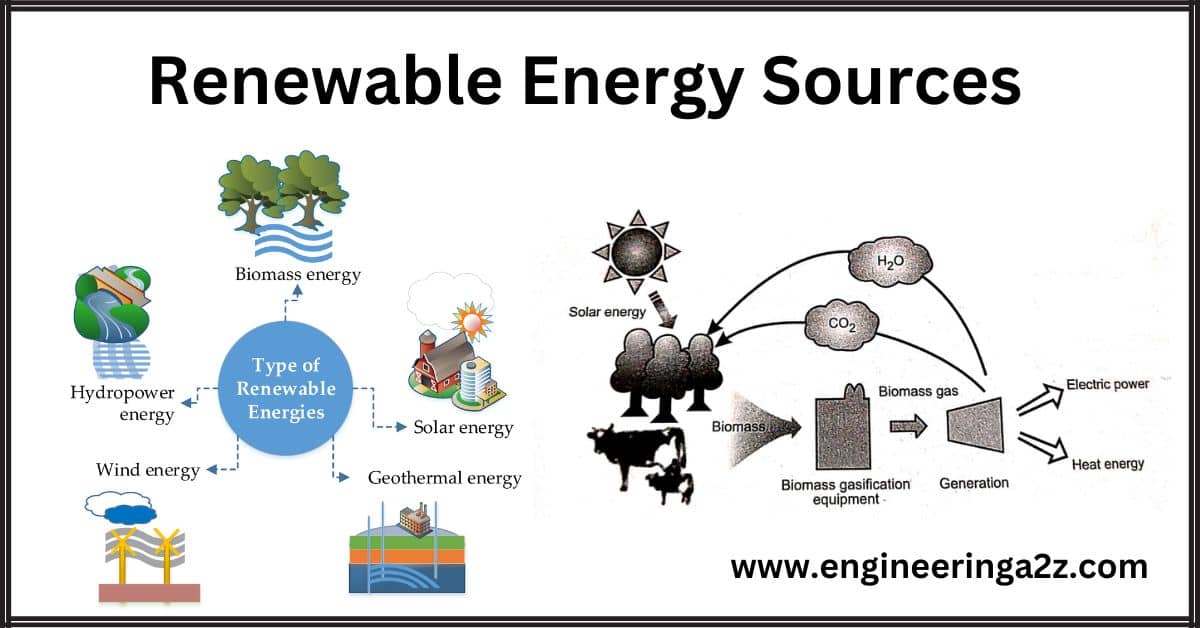
Table of Contents
Renewable Energy Sources
The sources of energy that can never get exhausted i.e. they can be reproduced again in the near future are called renewable energy sources—for example, wind energy, water energy, and solar energy, etc.
The renewable energy sources are explained as the following:
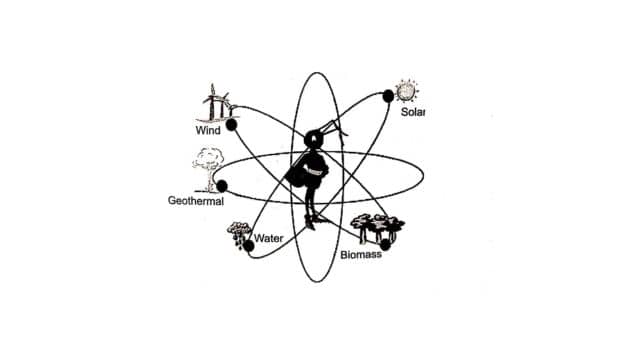
1. Wind Energy: Winds are produced by the sun’s uneven heating of the atmosphere. The kinetic energy of these winds is then used to run turbines in order to generate electricity. Areas, where wind flow is consistent and the flow rate is about 20 km/h or more are used to make wind power plants e.g. offshore.
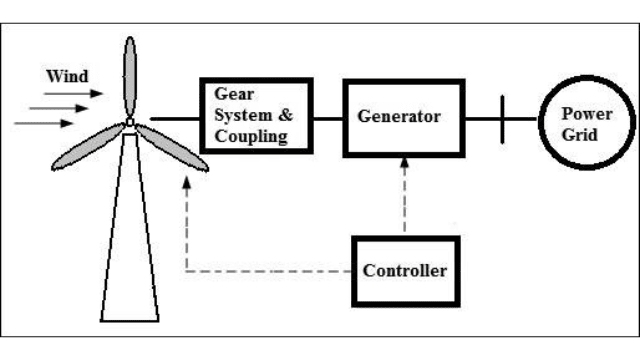
(i) The wind turbines convert the wind power into mechanical energy. This mechanical energy is then fed to the generator to produce electricity.
(ii) The wind turbine works opposite to a fan. Fans use electricity to make wind, and wind turbines use current to generate electricity. The wind rotates the turbine which in turn rotates the shaft of the dynamo to which it is connected to generate electricity.
2. Hydroelectric Energy: Hydropower is the most important and widely used renewable source of energy. Hydropower represents 19% of total electricity production. China is the largest producer of hydroelectricity, followed by Canada, Brazil, and the United States.
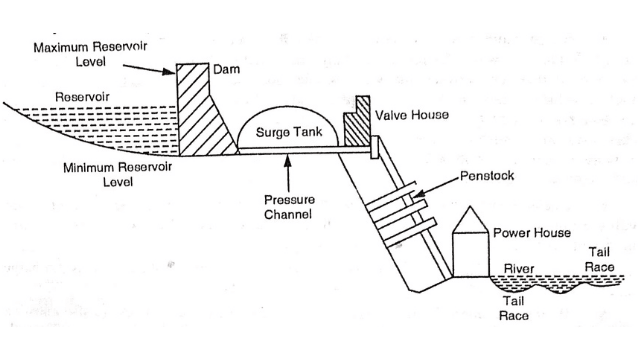
3. Solar Energy: Harnessing energy from the sun to perform some task is called star energy. We can use solar energy to heat water or homes and it can be converted into electricity. Converting solar energy to electricity occurs with the use of :
(i) Photovoltaic cells.
(ii) Solar power plants.
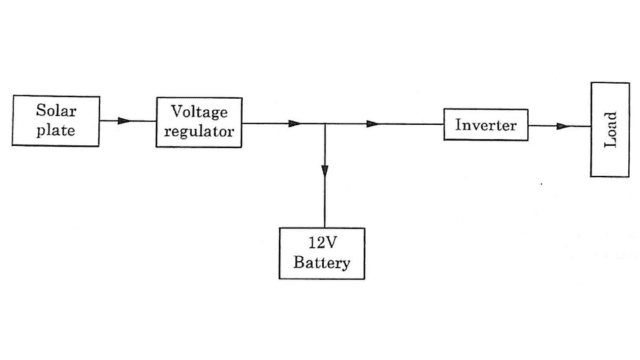
Photovoltaic cells are able to convert sunlight directly into electricity Solar power plants use solar energy to produce steam to operate general. Like wind energy, however, solar energy is limited in availability based on localized weather conditions, and it can be challenging to store the energy generated.
Sun does not provide constant energy, so to use uninterrupted power requires a battery to store solar energy when the solar panel is active i.e., it is generating electricity in the presence of the sun.
4. Geothermal Energy: Geothermal energy is the heat energy that is stored beneath the Earth’s surface. It is a type of renewable energy that is clean and sustainable. This energy is constantly available and can be used to heat homes, and offices, and even generate electricity.
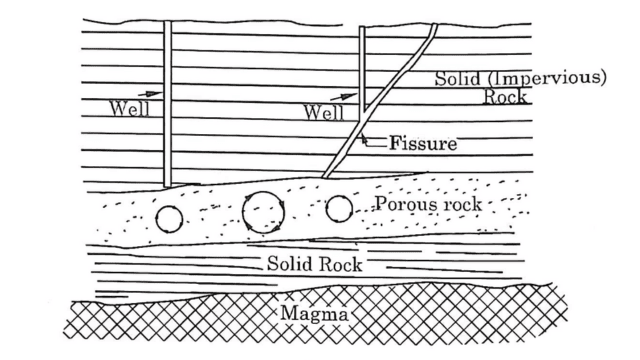
Our planet has a tremendous amount of energy stored within it. In fact, almost all of the Earth, about 99.9 percent, is hotter than 100 °C. This means that geothermal energy is a significant and reliable source of renewable energy. Humans have been harnessing geothermal energy for heating purposes for a very long time. In certain areas, natural underground water heated by geothermal energy rises to the surface and appears as hot springs or steam geysers. People have been using these hot springs and geysers for bathing and agriculture.
In simple terms, geothermal energy is the heat energy that comes from beneath the Earth’s surface. We can use this energy to keep our homes warm, power our buildings, and even generate electricity. It’s a clean and sustainable form of energy that we have been benefiting from since ancient times when people started using hot springs and geysers for various purposes.
5. Biomass Energy: Biomass energy includes a broad range of fuels including wood and other plant material, food waste, garbage, and manure. In the case of wood and plant materials. it can be processed and combusted for a beneficial end use such as generating electricity or firing a boiler.
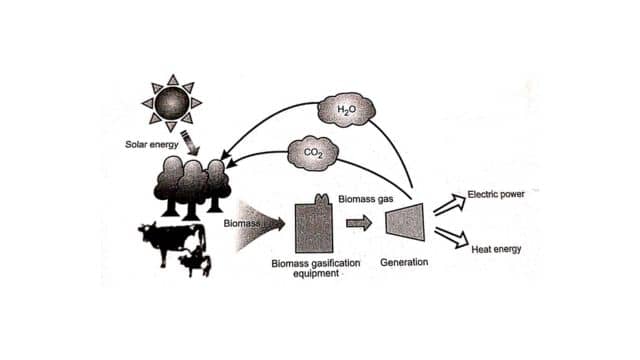
With food waste and manure, the gases resulting from the processes of decomposition of these materials can be harnessed and combusted for beneficial end use. Utilizing biomass for energy not only provides us with a renewable energy source but often allows us to put a material that would otherwise be considered waste to good use.
6. Ocean Energy: Around 70% of the earth’s surface is covered with ocean water. This is the reason that energy produced by this source of energy can be used on a much wider scale than any other source of energy. Ocean energy can be harnessed in three ways:
(i) Tidal energy
(ii) Wave energy
(iii) Ocean thermal energy conversion (OTEC)
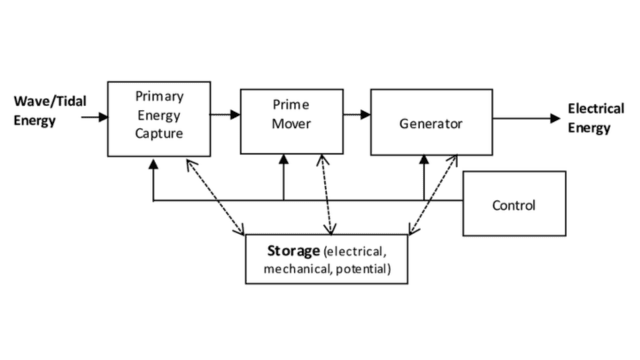
- Tidal energy generators use the rise and fall of tides to convert the kinetic energy of the tides to electrical energy. Tidal energy is considered:
(i) As a renewable source of energy as tides are produced constantly on seashores and can be used to produce electricity on a large scale.
(ii) Secondly, they are more predictable than wave energy.
- Wave energy on the other hand, is produced from the waves that are produced in the oceans.
(i) Waves are nothing but constant disturbances produced on the surface of the water.
(ii) Wave energy, like tidal energy, is completely renewable, widely available, environment friendly, and causes no damage to the land.
(iii) But the downside of using wave energy is that may affect marine ecosystems. suitable to certain locations, highly dependent on wavelength and source of disturbance to private and commercial vessels.
7. Hydrogen Energy: Hydrogen is a very common element on Earth, and it is found in water. Since about 70% of the Earth’s surface is covered with water, we have a lot of hydrogen available. When we separate hydrogen from water, we can use it to produce electricity.

The great thing about hydrogen is that it is completely renewable because we can always extract more from water, and we have a plentiful supply of water. So, we can rely on hydrogen as a source of energy without worrying about running out.
Advantages of Renewable Sources of Energy
The various advantages of renewable sources of energy are as the following:
- Renewable sources of energy are renewable and easily regenerated. This is unlike fossil fuels which are perishable once used.
- Renewable source of energy such as the sun produces clean energy that does not pollute the environment. This is because no burning is required during the usage of the energy.
- Most importantly, renewable sources of energy are available everywhere throughout the world, thus there is no chance of the sources becoming depleted in the future. For example, solar energy is everywhere as the sun will always be there every day.
- Maintenance cost needed to install and use the renewable energy is relatively cheap. Solar energy can be trapped easily and used for domestic needs.
- Renewable sources of energy boost economic growth and increase job opportunities. This includes electrical energy which is used to run many industries.
Disadvantages of Renewable Sources of Energy
Every set of energy has its own drawbacks once introduced to the ecology. Some of these limitations include the following:
- Difficult to produce the energy quantity that is equivalent to that produced by non-renewable fuels.
- Technology required to trap renewable energy is costly. The setting of dams requires high initial capital to construct and maintain.
- Most renewable sources of energy are affected by weather, thus reducing their reliability. For example, hydro generators need constant rainfall that will overflow the dams and wind turbines only rotate if there is wind of a given speed.
Frequently Asked Questions (FAQs)
-
What is Renewable Energy Source?
The sources of energy that can never get exhausted i.e. they can be reproduced again in the near future are called renewable energy sources—for example, wind energy, water energy, and solar energy, etc.
-
What are the advantages of wind energy?
(i) Wind turbines have a low impact on the environment; they produce only low-frequency noise.
(ii) It is safe and produces no byproducts. The turbines do not disturb livestock on farms and the land can continue to be used for grazing and crop production.
(iii) There are no interferences as in the past with television or radio frequencies. -
What are the disadvantages of biomass Energy?
(i) Collecting the waste in sufficient quantities can be difficult.
(ii) Fuel is still being burnt so this is still generating greenhouse gases.
Read Also:
- Difference Between A.C. and D.C.
- UPS | Types | Comparison Between Online and Offline UPS
- Output Equation of Transformer
- FACTS Controller | Types of FACTS Controller
- Dual Converter | Introduction, Operation Mode and Application











Leave a Reply